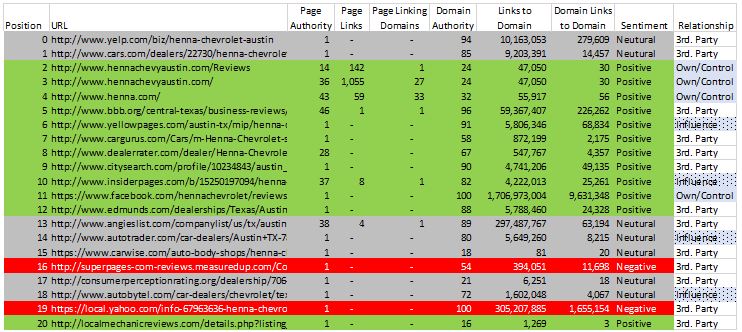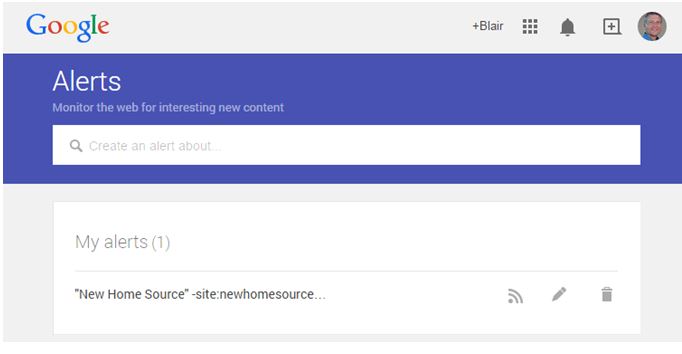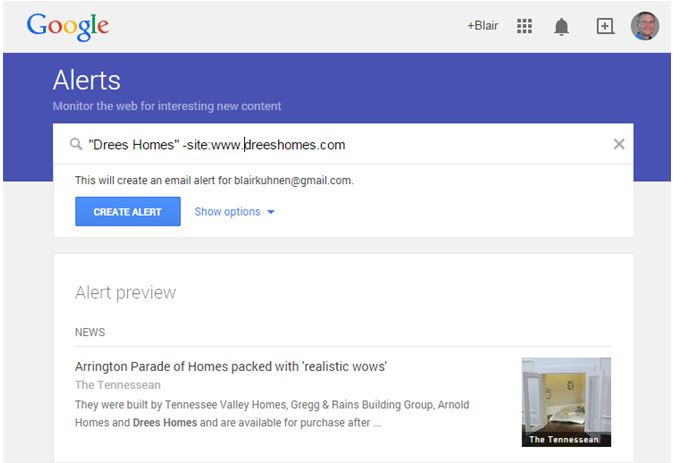This is the second of four blogs in our online reputation management series.
If you read our previous article, we took a deep dive into Builder Online Reputation Management. The first step to managing your reputation is to assess your current reputation. Start with a benchmark audit.
3-Steps in the Audit Process:
1. Gather and categorize reputation results through relevant lenses. We pull 3 pages of Google search results for keyword searches that are reflective of your reputation. Our main focus is on page 1, but on page 2 and 3 are your best opportunities to promote positive references. Feel free to use our reputation audit spreadsheet as a guide for this step. I have filled out the spreadsheet based on this example.
2. Identify the results on pages two and three that you want to promote and develop a plan for making these results more relevant. You want to cause things you own/control or are highly positive to be considered more relevant in the search results.
3. Continue to monitor your reputation online. Update your audit sheet bi-weekly while actively seeking to drive changes in the results, but monitor at least monthly for changes. Set up monitoring of your brand mentions. Many tools are available free or at moderate costs.
Gather and Assess Reputation Through Google Search Results
You need to view your reputation through three lenses: (1) a general brand view, (2) the view as someone looking for brand reviews, and (3) the view as a potential employee. We can assess your online brand reputation by using Google to search for:
[Your Brand Term only]
[Your Brand Term only] + reviews
[Your Brand Term only] + careers
For each search above, we are looking for two key things: (1) Positive information on sites you own/control or influence, and (2) results that are harmful to your reputation on the first two search results pages. Ideally, you will own/control most of page 1 and what you don’t own is influenced by you or favorable to your brand. Further, we want no negative reviews, particularly on the first 2 pages of Google search results. Based on your own situation, you may choose to modify or add to these guidelines. Just be consistent.
We care most about what shows up near the top of search results. Page 1 of Google is key since less than 6% of searchers will ever get to page 2 and less than 2% will get to page 3 (Source: Advanced Web Ranking’s 2014 Google Organic CTR Study).
For this example, I am going to pick a local Austin auto dealer, Henna Chevrolet, who we do not work with. So, let’s search for:
- Henna Chevrolet
- Henna Chevrolet reviews
- Henna Chevrolet careers
Save the first 3 pages of results. To make this easy, we use the Moz toolbar. While we are most concerned with page 1 and page 2, we may want to promote positive reviews from page 3. So, we pull these as well. Save all the results for possible analysis later. You will also want to put your findings in a spreadsheet that will make it easy to visualize results. In this sheet, we gather the following fields:
- URL
- Meta Title Tag
- Meta Description
- Moz Page Authority
- Page Links
- Page Linking Domains
- Moz Domain Authority
- Links to Domain
- Domain Links to your Domain
- Sentiment: Positive, Neutral, Negative, Not Applicable
- Relationship: Own/Control, Influence, 3rd Party
The finished product looks like this (title and descriptions hidden):
 This gives you a wealth of information. The goal is to make the positive and Owned/Controlled content more relevant so it ranks higher in Google. What is controlled content? This would include pages like your LinkedIn page and 3rd Party sites where you control the content. For example, the 6th listing in a branded search for Drees Homes on Google links to New Homes Source’s profile and reviews page for Drees Homes.
This gives you a wealth of information. The goal is to make the positive and Owned/Controlled content more relevant so it ranks higher in Google. What is controlled content? This would include pages like your LinkedIn page and 3rd Party sites where you control the content. For example, the 6th listing in a branded search for Drees Homes on Google links to New Homes Source’s profile and reviews page for Drees Homes.
You want to own or control most of what is displayed on page 1. Ideally, the only 3rd party information showing up are positive reviews or information. Coming in a future post in this series, we will give you steps you can take to push down negative reviews while promoting positive information about your brand. This does not mean you don’t take the other steps to address reputation issues, but promoting your positive press is critical.
Monitoring Your Brand Online
Monitoring your brand is easy and many tools are available. Some can be costly, but free options exists. You need to monitor two things: (1) your social media mentions and (2) anything showing up in Google search results. For social media monitoring, one of my favorite tools is Trackur.com. They have a 10-day free trial and costs $97/month after that. Want a free option? You can set up Google Alerts at no cost. To use it effectively, you need to know a little about Google advanced search operators, but it’s easy to set up and manage.
How to Set Up a Google Alert in 3 Easy Steps
First you need to have a Google account. It’s free and you can access all the tools Google offers at no cost. If you do not have an account you can sign up here.
1) Go to Google Alerts: https://www.google.com/alerts
2) Set Parameters for the Alert
Type in the search query and modifiers you want. For example, if I were Drees Homes I might want to search for exact matches on the full brand name “Drees Homes.” Since we don’t want to track mentions on our own website, we use the qualifier ‘-site:www.dreeshomes.com’ and looks like the example below. Google even brings up an example based on recent news for Drees Homes.
3) Select your options for the alert
For most of us, we only need to decide how often we want email alerts to come when Google finds something new. The options are: “As-it-happens,” “At most once per day,” or “At most once per week.” Then just hit the “Create Alert” button. You can edit or delete the alert at any time.

That’s it. You can set up as many as you want. You might set up alerts to track your executives mentioned in the news, specific negative review sites like “pissedconsumer”, competitor brand mentions, and community names. Each alert will send a separate email, so make sure you are being specific and sending at the frequency you want. Give it a try, you will like it.
In the next article in this series, we will share best practices for responding to negative reviews online. Remember, the number one way to build a better online reputation: be better.



